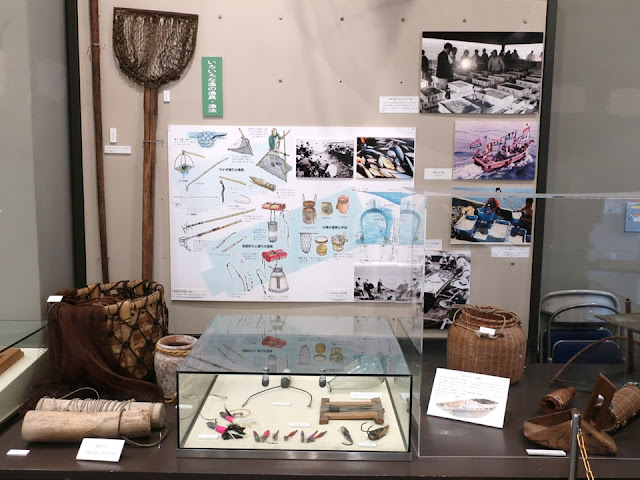Yaizu port has the third largest fish catches
in Japan (2021). The museum shows us the locals’
thoughts on building ships, catching and loving fishes. The exhibits about the fishing
vessel which was damaged by the US hydrogen bomb test in 1954, move us. We can
feel how fruitless a weapon development is.
日本三位の水揚げ量を誇る焼津港がある町です(2021年)。舟を作る、魚を獲る、魚を愛する気持ちが伝わりました。また、アメリカの水爆実験に巻き込まれた第五福竜丸についても沁みる展示がされていました。武器開発や戦争の害と無意味さを改めて感じます。
The museum is in Yaizu Cultural Center which has a large hall.
大ホールもある焼津市文化センター内に歴史民俗資料館があります。
We can take photos except for the special exhibition “Spaces wherein deities reside and Roads wherein people exchange”. It was interesting one in which the festival for the mountain deity and so on were exhibited.
展示室の企画展を除いて、撮影可能でした。企画展では、山の神祭など魅力的な展示がされていました。
Fishery、漁業
The section is very fruitful.
漁業のコーナーはとても充実しています。
People would be enthusiastic about catching, especially during a big catch.
こんなに獲れて、面白くてたまらなかったでしょう。
Tools and materials to build a ship. Shipwrights used three kinds of timbers (cypress, camphor and pine tree) which suited to each part of ship.
船を作る材料と道具の数々。桧、楠木、松を使い分けました。
The picture in the upper left is a commencement ritual of building a ship in around 1950. The wooden box in the upper right is Funa(ship)-dama(spirit)- sama. A pair of dolls and so on are put in it. A ship owner sets the box inside a mast during a launching ceremony. The replica of the hereditary scroll at the bottom tells shipwright how to build a ship and how to perform a ritual. They always pray to the deity for their safety. They are modest.
技術や儀式の執り行い方を伝えるために船大工が伝承していく巻物(下)、船の起工式(左上、昭和20年代)、そして、男女の人形などを入れた船霊様の箱(右上)が展示されています。船霊様は、進水式で帆柱に納めます。安全への願いです。神にすがる人々の謙虚さを感じます。
The lives of fishermen are exhibited in the section above. The coat at the right end was used while pole-and-line fishing of bonito which is the mainstream fish in Yaizu. The material of the coat is non-slip, because they hold a bonito under their arm and take off the hook.
漁民の暮らしを展示したコーナー。右端の服(カツーギ、鰹着)は、鰹の一般釣りのときに使いました。釣った魚を脇に挟んで針を外すのですが、鰹が滑りにくい服だったそうです。
There is a cut section model of a bonito fishing ship. Bonitos are thrown into the center tank cooled by ice. I'm sure it is an exciting job if we can encounter a bonito school.
洋型の鰹一本釣り漁船の断面が展示されています。氷室の間の水槽に釣った鰹を放り込んでいきます。群れに当たるとたまらんでしょうね。
The cotton shirt above was popular among bonito fishermen in the early 20th century. The indigo stripe pattern recalls a bonito. It was a uniform for bonito fishermen. The photo in the lower right is an unloading of bonito.
大正末期から昭和初期に流行したカツオ縞シャツです。木綿生地で、焼津のカツオ漁師のユニフォームでした。襟袖付です。右下は、鰹の水揚げ。
There were many fish related buildings on the street. Seafood processing (red), fish shops (green), fishermen (blue) and so on. They expanded their business from the coastal area to the ocean.
浜町通りは魚を扱う店で賑わいました。たくさんある赤は水産加工業、緑は鮮魚商、青は漁業従事者の家です。沿岸漁業から遠洋漁業へと発展しています。
At the section of the tragedy of the fishing vessel (Daigo Fukuryu Maru) damaged by the hydrogen bomb test, there are many exhibits which would cause the elimination of nuclear weapons; letters to the harmed fishermen and so on. Everyone hope that the world will become one without nuclear weapons, however, it would unhappily be a long journey. The actual ship is exhibited in Tokyo (http://d5f.org/en).
核廃絶を願う第五福竜丸の展示コーナー。別室では、被爆し死亡した船員の家族への手紙が展示されていて、人を殺すことを目的とした武器開発や戦争の罪を深く感じます。でも、なかなかなくならない。実物は東京の夢の島に展示されています。
From the history of Yaizu、焼津の歴史から
In the ancient section, the oldest straw shoe is exhibited, which was made in the late 5th century. Amazing!
1500年前の住居跡の復元の横に、日本最古のワラジ(5世紀後半)が展示されていました。ビックリ。
The Japanese badminton racket was excavated at the medieval castle ruin. The thing is that there is a dimple. If the player always hit the shuttlecock at the sweet spot, he/she was super! The racket is exhibited at the section which shows life and entertainment in a castle.
中世の城郭(小川城)から発掘された羽子板には、羽根を打った跡が残っています。いつも打ったスイートスポットの跡なら凄すぎ。城内での生活と遊びの道具の展示です。
I went to Yaizu Sakana (fish) Center after visiting to the museum. The origin is the black market after the WW2. The history aside, the sashimi rice bowl (upper right) was delicious.
帰りに焼津さかなセンターに寄りました。焼津駅前の闇市がルーツです。1985年に少し内陸部、東名高速の近くで開業しました。それはさておき、とても美味かった。
Visited in February, 2023
Official website: https://www.city.yaizu.lg.jp/english/index.html
https://www.city.yaizu.lg.jp/rekimin/ (in Japanese) accessed in July, 2023
Previous post (small museum in the same prefecture): Shimizu Port Seamen’s Inn
Museum、末廣(清水次郎長の船宿)
Next post (museum in the same prefecture): Shimada City Museum、島田市博物館














Comments
Post a Comment